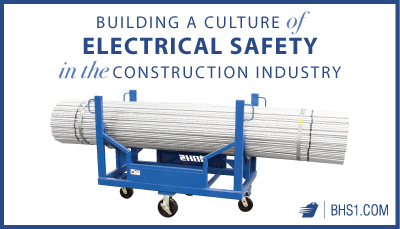We use cookies to make your experience better. To comply with the new e-Privacy directive, we need to ask for your consent to set the cookies. Learn more.
Building a Culture of Electrical Safety in the Construction Industry
Electrical safety in the construction industry has been studied, argued over, and refined since Thomas Edison started burying copper wires beneath the streets of Manhattan in 1882. From the National Fire Protection Association (NFPA) — which publishes NFPA 70, otherwise known as the National Electrical Code (NEC) — to the Occupational Safety and Health Administration (OSHA), all sorts of safety organization offer important insights into electrical safety.
No matter how well a construction electrician understands the NEC or OSHA regulations, though, the key to keeping every employee safe on every jobsite is to build a culture of safety into every workplace task — especially for those who install electrical systems. 
Safety cultures start at the top. Everyone in a leadership position must model the following behaviors in addition to insisting everyone else do the same:
-
Never fail to wear personal protective equipment (PPE).
Hardhats, insulating clothes, and safety glasses are never optional. It can be difficult to get every employee to use appropriate PPE for electrical installation jobs (especially on a hot day). But when shift leaders enforce a strict policy of compliance — and staff encourage each other to stay safe — it's harder to "forget" to put on your insulating gloves.
-
Always use lockout/tagout (LOTO) procedures as written.
The typical LOTO procedure forces staff to remove the possibility of accidental contact with a dangerous power source, a constant hazard of electrical work. Make frequent LOTO checks to ensure compliance with this crucial safety practice. In fact, employees should expect to see safety audits regularly.
-
Provide adequate electrical-material handling equipment for all tasks.
Electrical shock isn't the only safety hazard awaiting construction electricians. Manual material handling can be much more dangerous than you might assume, especially when you handle heavy reels of cable and large bundles of conduit.
Reduce the risk of musculoskeletal injury by providing material handling equipment designed specifically for electrical materials. For instance, Conduit Carrier Carts transport bulk quantities of conduit.
Of course, these tips are far from the only things electricians need to do to build a culture of safety in their workplaces. You might also want to improve communication between employers and their employees, as well as on a peer-to-peer basis. You might reward staff for closely following safety protocols.
You might even do what one maintenance manager does during shift meetings, according to an old issue of Electrical Construction & Maintenance magazine: He asked workers who were lax about safety glasses to stand up and explain how their career plans might change if they lost eyesight.
The point is, safety is worth every type of investment, from money to time. But the only way to really improve electrical safety in the construction industry is to build it into your workplace culture.
References:
Depue, Landon and Joe Miner. "Safety is a Culture Worth Adoption." EHSToday. Informa USA, Inc., 13 Dec. 2012. Web. 10 July 2018.
"History of Electricity." InstituteforEnergyResearch. Institute for Energy Research, 29 Aug. 2014. Web. 10 July 2018.
Lamendola, Mark. "Developing a Safety Culture in Your Business." ECMWeb. Informa USA, Inc., 1 May 1999. Web. 10 July 2018.
Rouse, Marty. "Creating a Safety Culture for Construction Sites." ECMWeb. Informa USA, Inc., 24 May 2011. Web. 10 July 2018.
